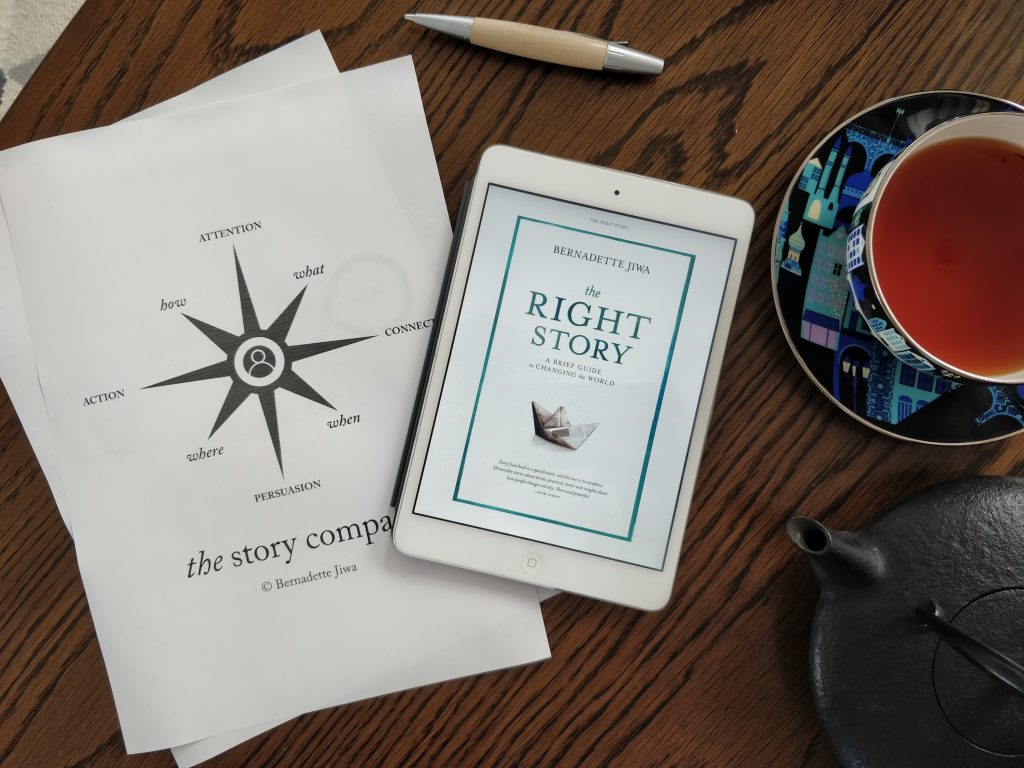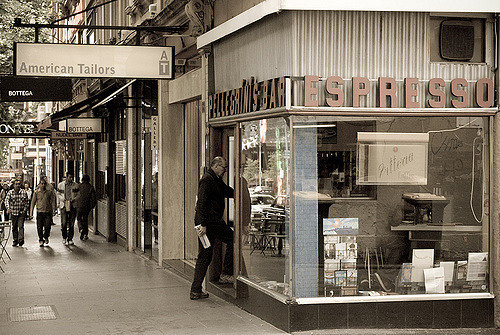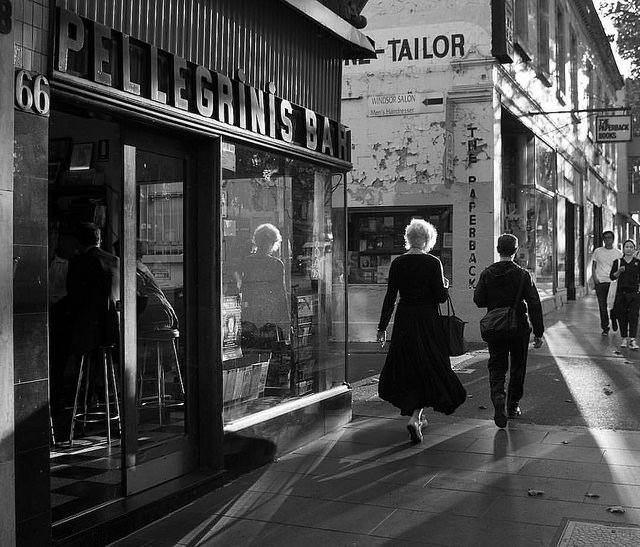Unlock the Magic in Your Story Now
Get the Free 20 questions to Ask Before Launching Your Idea workbook when you sign up for occasional updates.
Get the Free 20 questions to Ask Before Launching Your Idea workbook when you sign up for occasional updates.
Articles filed in: Storytelling
The Right Story
filed in Marketing, Storytelling, Strategy

What makes some bad ideas successful, and why do many good ideas fail? It turns out that there’s no such thing as a bad idea or a good idea. There is only the wrong story or the right story. The right story is one that is trusted. It is believed because it is told by the right person, for the right reasons, in the right way, at the right time, to the right people.
The success or failure of our ideas depends on us telling the right story. We can only do that by being clear about the change we want to create, and why—and then bringing enough of the right people with us on the journey. It’s up to us, the changemakers of today and tomorrow, to galvanise those people we hope to bring on the journey with us.
That’s why I wrote my new book, The Right Story. Not just to help you to persuade people or get better at delivering your message. But also to give you the tools to help you understand what should drive that message.
The Right Story will help you to resonate with your right people and become a more purposeful and powerful communicator. You’re the reason I wrote it. You can preorder your Kindle copy today—paperback copies will be available next week. I hope it helps you and your good ideas to succeed this year.
The Power Of What Goes Unnoticed
filed in Marketing, Storytelling, Strategy

The two sign installers stand back to assess their work before finishing the job. But something isn’t right. A couple of the large adhesive letters they have applied to the storefront window are crooked, and one of the men calls this out. His colleague agrees. The sign is definitely looking a little wonky. But, he reasons, if the store owners don’t care about fonts, they aren’t going to notice this.
‘Let’s just crack on with it,’ he says.
And they do. But something else is not right—something that skips his attention, as he turns to get the rest of the equipment from their van. His colleague’s smile slips, his shoulders slump. Even though he agrees that the store owner might not notice the sign isn’t perfect. He knows. And that knowing sucks all the joy out of the work.
We are not only showing up for customers. We are showing up to ourselves—to do work we’re proud of, even when no one is watching.
Image by Peter B
Forget Marketing
filed in Marketing, Storytelling

Forget marketing. Instead, sit down and reflect on what you want your customer to know about why you’re building what you’re building. Tell them everything. Write it down.
Start with how you got to this moment and how your journey to it has equipped you to help them. Tell your customers how you’re going to help and why it matters that you do. Then show them how their lives will be better because of what you created. Remind them what’s at stake.
Marketing doesn’t have to be about promoting and pitching. Marketing can be an honest conversation between two people (or groups of people), who need each other.
Image by Garry Knight
The Convenience Trap
filed in Marketing, Storytelling, Strategy

The homeless man sitting at the Brunswick Street junction doesn’t look up as people walk past. He doesn’t try to catch the eyes he knows are trying to avoid his. He lets the cardboard sign at his feet do the talking. The headline in red crayon tells us that he’s genuinely homeless. There isn’t enough time for a passer-by to take in the detail of most of the rest of what’s written on the sign in smaller print. But the unusual call to action at the bottom stands out.
‘If you’d like to consider regularly donating $5 a month please let me know.’
The homeless man request knows that he doesn’t just need more donors, he understands that he needs more of the right donors—who keep coming back.
In recent years we’ve seen the rise of businesses that make it easy for us to become returning customers. These businesses have worked out that convenience is sticky. And so we’ve seen the rise of subscription services for everything from razors to flowers and apps that will have a meal or ride to our door in minutes. But convenience alone isn’t what drives thriving, sustainable businesses. Companies that merely offer a convenient solution risk disruption. They must live in fear of the next new thing that’s closer or cheaper, faster or fancier.
If we want to earn loyal donors or customers, we must offer them more than convenience. Loyalty is a byproduct of resonance and convenience. Successful causes and companies don’t only make life easier for their donors or customers—they strike a chord with them too.
Image by Kevin McShane
Two Ways To Think About Selling
filed in Marketing, Storytelling, Strategy

Are you selling or are you showing up in the best light for the people who need you?
Sales can be a service. And vice versa.
Image by Garry Knight
Lucky By Design
filed in Storytelling, Strategy

The cathedral was packed. More than a thousand people arrived on a warm Tuesday morning to attend cafe owner, Sisto Malaspina’s funeral. Many more stood outside—others watched the service at home on their laptops or giant screens in Melbourne’s Federation Square. We were there, not to mourn Sisto’s death, but to celebrate how he had lived. Sisto was a man who was grateful for the privilege to serve people. He felt fortunate to do work that mattered to him. And how he did that work became a reflection of his life and his legacy. Sisto was lucky, for sure.
After the service, the crowd slowly filed out the front entrance. People began talking as we got closer to the door. Two men behind me spoke about the service. Then one asked the other what he was up to next. “Are you heading back to work?” “Yeah, worse luck,” his friend replied.
During the service, one of Sisto’s customers (and friends) had spoken about why he would be missed. “You loved us, and we loved you,” he said. But then he went on to say something that people don’t often articulate. “There’s been a moment when we all wished we were Sisto.”
It was true. Everyone wants to show up to work with as much gratitude and joy, passion and pride as Sisto had done. Not just the people who were fortunate enough to be served coffee or pasta by him at Pellegrini’s—but you and me too.
It’s easy to think that it was alright for Sisto. He had his own business. He was doing something he loved. He was in charge of his destiny. He was one of the lucky ones. Many of us are not that lucky. But what if we could find a way to feel like Sisto? To be lucky by design and to feel fortunate for the work we do—whatever that work is. What if we looked for the moments in our day to make a difference? And if we can’t find some joy in our work, a way to do it with heart and soul, then maybe it’s time to think about how we could change that too?
Image by Valberg Larusson
Nurture Vs. Growth
filed in Storytelling, Strategy, Success

It’s virtually impossible to think of building a successful business (or life) without having the intention to grow. But sometimes growth for growth’s sake can be a trap. The idea that we have to make a particular metric go up at all costs can lead to unintended compromises. What if instead of thinking about growing our businesses, our expertise or our influence, we thought about how we could nurture them instead?
When we begin to think in terms of nurturing (protecting something while it grows), we are compelled to be more intentional about how we grow. And focusing on how makes all the difference.
Why does your business need to grow?
How does it need to grow?
What does sustainable growth look like for you?
What are you unwilling to compromise on to achieve growth?
What else should you consider before making your next move?
Every journey involves making two decisions. We happily get to where we’re going by figuring out where we want to end up and how we want to get there. Success comes in more than one flavour.
Image by Garry Knight
Becoming Better Storytellers
filed in Marketing, Storytelling, Strategy

We’ve all heard the news that attention spans are shrinking. We’ve come to believe that the people we’re trying to reach are always distracted. If that’s so, how do we explain the rise of binge-watching, the success of serialised podcasts and long read articles? What we’re witnessing isn’t just a shift in the way content is consumed. It’s a change in the intention and behaviour of both audiences and content creators according to their preferred platform or media.
The goal of prolific tweeters and grammers is to distract, rather than to immerse their audience. People visit Twitter and Instagram when they want to be distracted. Steaming services want to keep us watching. Their intention gives rise to the creation of engaging content and better storytelling.
How we tell stories changes how people react and respond. How audiences react and respond changes the kinds of stories we tell.
We become better storytellers by knowing who we are and who we want to be to whom. Purposeful storytellers are intentional about the impact they want to have and the messages they choose to send.
How We Do Matters
filed in Storytelling, Strategy
 One of the owners of Melbourne’s most iconic café died tragically a week ago. Sisto Malaspina had been serving espresso to Melburnians at Pellegrini’s since 1974. Tributes poured in from across the community about the impact he and his café had on people and the city. The one that struck me was the story told by a man who arrived in Melbourne to start a new job, with little more than the clothes on his back. When he asked people where he should eat, they said, head to Pellegrini’s. They will feed you like family. Like family.
One of the owners of Melbourne’s most iconic café died tragically a week ago. Sisto Malaspina had been serving espresso to Melburnians at Pellegrini’s since 1974. Tributes poured in from across the community about the impact he and his café had on people and the city. The one that struck me was the story told by a man who arrived in Melbourne to start a new job, with little more than the clothes on his back. When he asked people where he should eat, they said, head to Pellegrini’s. They will feed you like family. Like family.
Making people feel like family was intentional, a choice Sisto and his team made every day.
A choice his business partner and his team will continue to make now he’s gone.
Image by David Brewster
 Who loves what you do?
Who loves what you do?